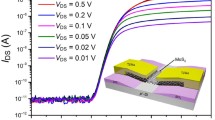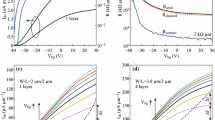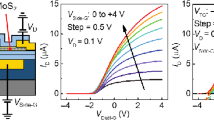Abstract
Molybdenum disulfide (MoS2) is a typical semiconductor two-dimensional atomic crystal material, which has excellent physical and electrical properties and so shows great potential in Nano-electronic and optical applications. The regulation of channel characteristics is a key problem in practical application. In this paper, the MoS2 FET are studied with respect to the number of MoS2 layers in the channel. In the study of direct tunneling characteristics, the effects of image potential and no parabolic linearity of the energy band are considered. The results show that with the increase in the number of MoS2 layers, the direct tunneling current increases and the threshold voltage decreases. In addition, a MoS2 FET with a single layer MoS2 structure can obtain a low subthreshold swing (70 mV/dec). MoS2-based devices can solve the problem that the switching speed of traditional silicon-based devices cannot be effectively improved at the nanoscale. Our results show that varying MoS2 layers could regulate the channel characteristics and improve its performance.








Similar content being viewed by others
Data availability
The authors declare that data supporting the findings of this study are available within the article [and its supplementary information files].
References
A.K.A. Lu, G. Pourtois, M. Luisier, I.P. Radu, M. Houssa, On the electrostatic control achieved in transistors based on multilayered MoS2: a first-principles study. J. Appl. Phys. 121, 044505 (2017). https://doi.org/10.1063/1.4974960
F. Schwierz, J. Pezoldt, R. Granzner, Two-dimensional materials and their prospects in transistor electronics. Nanoscale 7, 8261–8283 (2015). https://doi.org/10.1039/c5nr01052g
K.I. Bolotina, K.J. Sikes, Z. Jiang, M. Klima, G. Fudenberg, J. Hone, P. Kim, H.L. Stormer, Ultrahigh electron mobility in suspended graphene. Solid State Commun. 146, 351–355 (2008). https://doi.org/10.1016/j.ssc.2008.02.024
M. Shin, M.J. Lee, J.H. Lee, B.H. Park, S. Lee, J.G. Park, Electrical properties of mos2 field-effect transistors in contact with layered CrPS4. J. Korean Phys. Soc. 76, 731–735 (2020). https://doi.org/10.3938/jkps.76.731
A.M. van Der Zande et al., Tailoring the electronic structure in bilayer molybdenum disulfide via interlayer twist. Nano Lett. 14(7), 3869–3875 (2014). https://doi.org/10.1021/nl501077m
M. Berg et al., Layer dependence of the electronic band alignment of few-layer MoS2 on SiO2 measured using photoemission electron microscopy. Phys. Rev. B 95, 235406 (2017). https://doi.org/10.1103/PhysRevB.95.235406
K.F. Mak, C. Lee, J. Hone, J. Shan, T.F. Heinz, Atomically thin MoS2: a new direct-gap semiconductor. Phys. Rev. Lett. 105, 136805 (2010). https://doi.org/10.1103/PhysRevLett.105.136805
S. Huang, X. Ling, L. Liang, J. Kong, H. Terrones, V. Meunier, M.S. Dresselhaus, Probing the interlayer coupling of twisted bilayer MoS2 using photoluminescence spectroscopy. Nano Lett. 14, 5500–5508 (2014). https://doi.org/10.1021/nl5014597
K. Liu, L. Zhang, T. Cao, C. **, D. Qiu, Q. Zhou, A. Zettl, P. Yang, S.G. Louie, F. Wang, Evolution of interlayer coupling in twisted molybdenum disulfide bilayers. Nat. Commun. 5, 4966 (2014). https://doi.org/10.1038/ncomms5966
Y.P. VenkataSubbaiah, K.J. Saji, A. Tiwari, Atomically thin MoS2: a versatile nongraphene 2D material. Adv. Funct. Mater. 26, 2046–2069 (2016). https://doi.org/10.1002/adfm.201504202
T. Li, G. Galli, Electronic properties of MoS2 nanoparticles. J. Phys. Chem. C 111, 16192–16196 (2007). https://doi.org/10.1021/jp075424v
E.S. Kadantsev, P. Hawrylak, Electronic structure of a single MoS2 monolayer. Solid State Commun. 152, 909–913 (2012). https://doi.org/10.1016/j.ssc.2012.02.005
A. Kuc, N. Zibouche, T. Heine, Influence of quantum confinement on the electronic structure of the transition metal sulfide TS2. Phys. Rev. B 83, 245213 (2011). https://doi.org/10.1103/physrevb.83.245213
C. Ataca, H. Şahin, S. Ciraci, Stable, single-layer MX2 transition-metal oxides and dichalcogenides in a honeycomb-like structure. J. Phys. Chem. C 116, 8983–8999 (2012). https://doi.org/10.1021/jp212558p
B. Radisavljevic, A. Radenovic, J. Brivio, V. Giacometti, A. Kis, Single-layer MoS2 transistors. Nat. Nanotechnol. 6, 147–150 (2011). https://doi.org/10.1038/nnano.2010.279
A. Mukhopadhyay, S. Kanungo, H. Rahaman, The effect of the stacking arrangement on the device behavior of bilayer MoS2 FETs. J. Comput. Electron. 20, 161–168 (2021). https://doi.org/10.1007/s10825-020-01636-w
N. Cortés, L. Rosales, P.A. Orellana, A. Ayuela, J.W. González, Stacking change in MoS2 bilayers induced by interstitial Mo impurities. Sci. Rep. 8, 2143 (2018). https://doi.org/10.1038/s41598-018-20289-1
J. Kwon, J.Y. Lee, Y.J. Yu, C.H. Lee, X. Cui, J. Honed, G.H. Lee, Thickness-dependent Schottky barrier height of MoS2 field-effect transistors. Nanoscale 9, 6151–6157 (2017). https://doi.org/10.1039/c7nr01501a
W. Wu et al., Piezoelectricity of single-atomic-layer MoS2 for energy conversion and piezotronics. Nature 514, 470–474 (2014). https://doi.org/10.1038/nature13792
A. Splendiani et al., Emerging photoluminescence in monolayer MoS2. Nano Lett. 10(4), 1271–1275 (2010). https://doi.org/10.1021/nl903868w
Y. Kim, T. Kim, E.K. Kim, High-performance MoS2/p+-Si heterojunction field-effect transistors by interface modulation. Nano Res. 15, 6500–6506 (2022). https://doi.org/10.1007/s12274-022-4263-0
G. Arutchelvan et al., Impact of device scaling on the electrical properties of MoS2 field-effect transistors. Sci. Rep. 11, 6610 (2021). https://doi.org/10.1038/s41598-021-85968-y
E. Gholinataj-Jelodar, A. Aghanejad Ahmadchally, A. Gooran-Shoorakchaly, M. Gholipour, Semi-analytical SPICE-compatible ballistic I-V model for 5 nm channel MoS2 FETs. J. Comput. Electron. 21, 1108–1115 (2022). https://doi.org/10.1007/s10825-022-01917-6
M. Gholipour, A compact short-channel model for symmetric double-gate TMDFET in subthreshold region. IEEE Trans. Electron Devices 64, 3466–3469 (2017). https://doi.org/10.1109/TED.2017.2716951
N.K. Singh, M. Kumari, M. Sahoo, A compact short-channel analytical drain current model of asymmetric dual-gate TMD FET in subthreshold region including fringing field effects. IEEE Access 8, 207982–207990 (2020). https://doi.org/10.1109/ACCESS.2020.3038421
M. Choi, J.W. Lee, H.S. Lee, Optical and electrical characterizations of volatile do** effect originated from bilayer photoresist process in MoS2 field-effect transistors. J. Korean Phys. Soc. 81, 317–324 (2022). https://doi.org/10.1007/s40042-022-00525-8
L. Zhang, H. **ng, M. Yang, Q. Dong, H. Li, S. Liu, Advances in atomic layer deposited high-κ inorganic materials for gate dielectrics engineering of two-dimensional MoS2 field effect transistors. Carbon Lett. 32, 1247–1246 (2022). https://doi.org/10.1007/s42823-022-00367-1
Y.Q. Hu, P.S. Yip, C.W. Tang, K.M. Lau, Q. Li, Interface passivation and trap reduction via hydrogen fluoride for molybdenum disulfide on silicon oxide back-gate transistors. Semicond. Sci. Technol. 33, 045005 (2018). https://doi.org/10.1088/1361-6641/aaa224
C. Ataca, M. Topsakal, E. Aktürk, S. Ciraci, A comparative study of lattice dynamics of three- and two-dimensional MoS2. J. Phys. Chem. C 115(33), 16354–16361 (2011). https://doi.org/10.1021/jp205116x
L.P. Feng, J. Su, S. Chen, Z.T. Liu, First-principles investigations on vacancy formation and electronic structures of monolayer MoS2. Mater. Chem. Phys. 148, 5–9 (2014). https://doi.org/10.1016/j.matchemphys.2014.07.026
S. Bhattacharyya, A.K. Singh, Semiconductor-metal transition in semiconducting bilayer sheets of transition-metal dichalcogenides. Phys. Rev. B 86, 75454 (2012). https://doi.org/10.1103/PhysRevB.86.075454
S.W. Han, H. Kwon, S.K. Kim, S. Ryu, W.S. Yun, D.H. Kim, J.H. Hwang, J.S. Kang, J. Baik, H.J. Shin, S.C. Hong, Band-gap transition induced by interlayer van der Waals interaction in MoS2. Phys. Rev. B 84, 045409 (2011). https://doi.org/10.1103/PhysRevB.84.045409
A. Dashora, U. Ahuja, K. Venugopalan, Electronic and optical properties of MoS2 (0001) thin films: feasibility for solar cells. Comput. Mater. Sci. 69, 216–221 (2013). https://doi.org/10.1016/j.commatsci.2012.11.062
R. Ganatra, Q. Zhang, Few-layer MoS2: a promising layered semiconductor. ACS Nano 8(5), 4074–4099 (2014). https://doi.org/10.1021/nn405938z
H.X. Li, A.M. Ji, C.Y. Zhu, L. Cui, L.F. Mao, Layer-dependent bandgap and electrical engineering of molybdenum disulfide. J. Phys. Chem. Solids 139, 109331 (2020). https://doi.org/10.1016/j.jpcs.2020.109331
M.M. Furchi, D.K. Polyushkin, A. Pospischil, T. Mueller, Mechanisms of photoconductivity in atomically thin MoS2. Nano Lett. 14, 6165–6170 (2014). https://doi.org/10.1021/n1502339q
C.G. Van de Walle, R.M. Martin, Theoretical study of band offsets at semiconductor interfaces. Phys. Rev. B 35, 8154–8165 (1987). https://doi.org/10.1103/PhysRevB.35.8154
Y. Ando, T. Itoh, Calculation of transmission tunneling current across arbitrary potential barriers. J. Appl. Phys. 61, 4 (1987). https://doi.org/10.1063/1.338082
M. Rudan, Physics of Semiconductor Devices (Springer, New York, 2018). https://doi.org/10.1007/978-3-319-63154-7
L. Mao, C. Tan, M. Xu, The effect of image potential on electron transmission and electric current in the direct tunneling regime of ultra-thin MOS structures. Microelectron. Reliab. 41, 927–931 (2001). https://doi.org/10.1016/S0026-2714(01)00037-3
J. Lee, C.B. Su, Near ballistic transport in a nonparabolic-band structure for n- and p-GaAs. Electron Devices IEEE Trans. 29, 933–935 (1982). https://doi.org/10.1109/t-ed.1982.20805
C.R. Pidgeon, R.N. Brown, Interband magneto-absorption and faraday rotation in InSb. Phys. Rev. 146(2), 575–538 (1966). https://doi.org/10.1103/physrev.146.575
P.A. Sandborn, A. Rao, An assessment of approximate nonstationary charge transport models used for GaAs device modeling. IEEE Trans. Electron Devices 36(7), 1244–1253 (1989). https://doi.org/10.1109/16.30929
V.M. Polyakov, F. Schwierz, Influence of band structure and intrinsic carrier concentration on the THz surface emission from InN and InAs. Semicond. Sci. Technol. 22(9), 1016–1020 (2007). https://doi.org/10.1088/0268-1242/22/9/007
M. Lenzlinger, E.H. Snow, Fowler-Nordheim tunneling into thermally grown SiO2. J. Appl. Phys. 40, 278 (1969). https://doi.org/10.1063/1.1657043
J.H. Kim, T.H. Kim, H. Lee, Y.R. Park, W. Choi, C.J. Lee, Thickness-dependent electron mobility of single and few-layer MoS2 thin-film transistors. AIP Adv. 6, 065106 (2016). https://doi.org/10.1063/1.4953809
M.B. Barron, Low level currents in insulated gate field effect transistors. Solid State Electron. 15(3), 293–302 (1972). https://doi.org/10.1016/0038-1101(72)90084-6
W.M. Gosney, Subthreshold drain leakage currents in MOS field-effect transistors. IEEE Trans. Electron Devices 19(2), 213–219 (1972). https://doi.org/10.1109/T-ED.1972.17399
V. Mishra et al., Screening in ultrashort (5 nm) channel MoS2 transistors: a full-band quantum transport study. IEEE Trans. Electron Devices 62(8), 2457–2463 (2015). https://doi.org/10.1109/TED.2015.2444353
Acknowledgements
This work was supported by the National Natural Science Foundation of China under Grant [Grant no. 61774014]; the Financial aid for the “QINGLAN project” in Jiangsu Province[Grant no. 20210310]; the Special fund project for the transformation of scientific and technological achievements in Jiangsu Province [Grant no. BA2021077]; the Natural Science Foundation Surface Project of the Jiangsu Suqian of China [Grant no. K202013]; and the School-level Scientific Research and Innovation Team of Suqian University [Grant no. 2021td02].
Funding
Funding was provided by Innovative Research Group Project of the National Natural Science Foundation of China (Grant no. 61774014), the “QINGLAN project” in Jiangsu Province (Grant no. 20210310), the Special fund project for the transformation of scientific and technological achievements in Jiangsu Province (Grant no. BA2021077), the Natural Science Foundation Surface Project of the Jiangsu Suqian of China (Grant no. K202013), Science and Technology Support Plan for Youth Innovation of Colleges and Universities of Shandong Province of China (Grant no. 2021td02).
Author information
Authors and Affiliations
Contributions
All authors contributed to the study conception and design. Material preparation, data collection and analysis were performed by HL, YL, HJ and LM. The first draft of the manuscript was written by YN and all authors commented on previous versions of the manuscript. All authors read and approved the final manuscript.
Corresponding author
Ethics declarations
Competing interests
The authors declare no competing financial interest.
Additional information
Publisher's Note
Springer Nature remains neutral with regard to jurisdictional claims in published maps and institutional affiliations.
Rights and permissions
Springer Nature or its licensor (e.g. a society or other partner) holds exclusive rights to this article under a publishing agreement with the author(s) or other rightsholder(s); author self-archiving of the accepted manuscript version of this article is solely governed by the terms of such publishing agreement and applicable law.
About this article
Cite this article
Li, H., Li, Y., Jiang, H. et al. Characteristic analysis of the MoS2/SiO2 interface field-effect transistor with varying MoS2 layers. J Mater Sci: Mater Electron 34, 427 (2023). https://doi.org/10.1007/s10854-023-09869-8
Received:
Accepted:
Published:
DOI: https://doi.org/10.1007/s10854-023-09869-8




